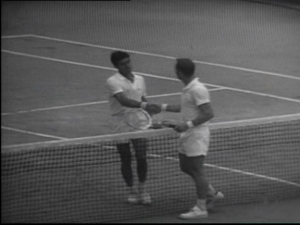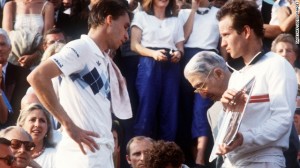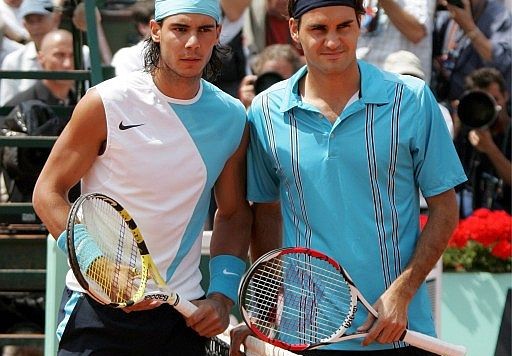It’s an old trick when you’re doing a list of five, but this is an occasion in which a fifth-place tie really is needed to put six matches on the short list of the most significant encounters ever staged at France’s major tennis tournament.
Go through this list. Just exactly which match doesn’t drip with all-time significance, such that it should fail to make the cut?
5 – TIE: 1927 FINAL AND 1969 FINAL
1927: RENE LACOSTE d. BILL TILDEN, 6-4, 4-6, 5-7, 6-3, 11-9
1969: ROD LAVER d. KEN ROSEWALL, 6-4, 6-3, 6-4
The 1927 final carries tremendous long-term historical value even now. “Big Bill” Tilden won seven U.S. championships and three Wimbledons in his career, but a tournament victory on red clay would have elevated his name in discussions of the sport’s greatest players. From 1898 through 1926, every French championship tournament (not referred to as Roland Garros in its early days; Roland Garros was a World War I French aviator who was killed in 1918, and Stade Roland Garros wasn’t built until 1928…) featured an all-French title match. That run was snapped by Tilden, who powered his way into the ’27 title tilt and carried the banner for the United States.
The stakes were evident 87 years ago: Tilden was trying to win the French for the first time, which would have put each of the three most prestigious majors in his trophy case. Many players didn’t travel Down Under for the Australian championships, a “major” — it should be said — which wasn’t all that “major” until it adopted a 128-player field in 1988. Tilden winning the French would have rippled through the pages of time.
On the other side of the net stood Rene Lacoste, whose name has endured in the realms of fashion and athletic apparel. Lacoste, though, was more than just an icon off the court; he first became an elite player. Moreover, he and two of France’s other “Four Musketeers,” Jean Borotra and Henri Cochet, had begun to establish dominance of the French championships. From 1924 through 1926, each man won the French once. Tilden wasn’t just facing Lacoste in 1927; he was facing one of the Musketeers in the middle of that group’s glistening reign over clay-court tennis. If Tilden had been able to pierce the Musketeers’ iron grip on their home tournament, his conquest of the French championships would have become that much more substantial. Lacoste, for his part, was defending not just his own honor and his country’s honor; he was playing for the greatest collection of tennis players France has ever produced.
The conclusion: Because Lacoste won, the Musketeers were able to maintain control of the French championships without interruption, through 1932. Their nine-year lock on tennis’s clay-court major wasn’t broken until Jack Crawford beat another Musketeer, Cochet, in the 1933 final. Tilden reached the French final one more time in 1930, but Cochet handled him in four sets, pulling away at the end. The 1927 final was Tilden’s chance to break through, but Lacoste nipped him at the wire in an “extra innings” deciding set. How different history might have been if Tilden, not Lacoste, had the “11” and not the “9” in the fifth set.
*

At a time in tennis history when only one major was not played on grass, Rod Laver’s Roland Garros championship stood out as the victory that enabled him to forge a special achievement… again.
The story attached to Rod Laver’s win over Ken Rosewall in the 1969 Roland Garros final is a very simple one. Three of the four majors were held on grass through 1974. The U.S. Open switched to green clay in 1975 and hardcourt in 1978. The Australian Open switched to hardcourt in 1988. Before those changes, however, tennis was mostly a lawn sport at the major-tournament level.
Roger Federer was (and is) no slouch on clay, but clay has always been Rafael Nadal’s sanctuary. Federer could not solve Nadal on the dirt, and that reality has dramatically changed the course of tennis history. (More will be said about this topic in a few moments.) In 1962, though, Laver — as an amateur — won on Parisian clay as well as on grass at the other three majors. In 1969, Laver’s win over Rosewall at Roland Garros enabled him to become the only man who has ever won the calendar Grand Slam in the open era of tennis, which began in 1968. Federer and Novak Djokovic came close to the calendar Grand Slam (in 2006 and 2007 for Federer, 2011 for Djokovic), but Roland Garros was the piece of the puzzle which eluded them.
Laver’s ability to not only win the calendar Grand Slam twice, but to do so in the amateur and Open eras and seven years apart rates as a feat that is just about impossible to top. Today, grass-court tennis owns just four weeks on the yearly calendar. Yet, Laver’s achievement stands as enduring proof of his greatness. Had Laver been able to compete in the majors throughout the 1960s, one can only imagine how many he would have won. This is why Laver continues to merit serious consideration as the greatest male singles player of all time.
4 – 1999 FINAL: ANDRE AGASSI d. ANDREI MEDVEDEV, 1-6, 2-6, 6-4, 6-3, 6-4
In a career that seemingly had four or five second acts, Andre Agassi suffered his most crushing defeats at two tournaments: The U.S. Open (specifically to Pete Sampras) and Roland Garros. In 1990, Agassi lost the French Open to Andres Gomez in what rated as a genuine (though perhaps not seismic) upset. He lost to Jim Courier in the 1991 final. Therefore, when he made his way to the 1999 Roland Garros final against a much lesser name on the tennis scene, Agassi had a chance to beat a different “Andrei” and achieve a career Grand Slam. Medvedev, however, came out of the blocks hitting freely and easily, barely breaking a sweat in the process of rolling up a two-set lead. Agassi was headed toward yet another gut-punch Sunday in Paris, recalling the misery of 1990 and ’91.
Yet, much as he emerged from the rubble of a tailspin on prior occasions in his career, Agassi somehow gathered himself and shifted the balance of the competition. He denied Medvedev easy point-ending opportunities in the third set. He also improved his return game, thereby applying match pressure to the Ukrainian, who began to feel the enormity of the moment. The burden of the day rested on Agassi’s shoulders at the beginning of the proceedings, but that weight shifted to Medvedev early in the fourth set. Agassi was able to remain in control to the end. He found the finish line this time, and in an instant, nine years of demons slid right off his back.
The 1999 Roland Garros tournament remains one of the most poetically poignant majors in tennis history. Steffi Graf and Andre Agassi scored supremely satisfying championships on consecutive days. Before they were married in flesh and spirit, they were brought together in the history books 15 years ago.
3 – 1984 FINAL: IVAN LENDL d. JOHN McENROE, 3-6, 2-6, 6-4, 7-5, 7-5

Two careers and two styles of play moved in different directions at the end of the 1984 Roland Garros men’s tournament. The impact on men’s tennis in the 1980s and beyond was considerable.
Is there a more significant men’s tennis match from the 1980s? This is certainly in the top three at the very least.
McEnroe’s 1984 season is easily one of the best in the history of tennis. Johnny Mac went 82-3, slashing through the rest of the ATP Tour. Yet, McEnroe won only two majors, because one of his three losses occurred in Paris. (He didn’t compete in the Australian Open.) This is the loss which lingers over McEnroe’s career even to this day, because it’s the loss that has the highest “what might have been” quotient… by a considerable margin.
Had McEnroe conquered red clay with his serve-and-volley game, the New Yorker might have remained inspired and liberated enough to translate his virtuosity into sustained dominance over the remainder of the 1980s. Had McEnroe not lost a two-set lead on that day in the City of Light, he probably would have been motivated enough to complete the career Grand Slam in due time. Had McEnroe not faltered after blitzing Lendl in the first two sets, the serve-and-volley game that found life in Stefan Edberg’s and Boris Becker’s careers might have become even more prevalent in men’s tennis.
Instead, Lendl — who appeared to quit in the face of Jimmy Connors’s determination in the 1983 U.S. Open final — finally found the major-tournament breakthrough which had eluded him over the previous three years. Just when Lendl’s toughness had been questioned to the fullest possible extent, the Czech then crossed the threshold. It was Lendl’s game, built on the foundation of a powerful serve and a punishing forehand, that took root in men’s tennis in subsequent decades. Lendl, not McEnroe, won the long-term stylistic war on the ATP Tour, and this match played a part in shaping that part of the sport’s journey in the 1990s and beyond.
The realities attached to this match and its aftermath could not be more stark: On one day, two of tennis’s greatest careers broke in dramatically different directions. More than that, two sharply contrasting styles of tennis were affected. To what extent, though? That’s the question which will never receive a particularly precise answer. Nevertheless, it’s hard to deny the notion that if McEnroe had won this match, the story of men’s tennis would have become very different. Heck, maybe Ivan Lendl never would have matured into the champion he became… a champion with enough credibility to guide Andy Murray to two major titles.
2 – 2009 FOURTH ROUND: ROBIN SODERLING d. RAFAEL NADAL, 6-2, 6-7 (2), 6-4, 7-6 (2)
A lot has been written about the four matches above, in part because modern-day fans — especially those pulled to tennis by Roger Federer and Rafael Nadal — might not be aware of the contextual details attached to them.
The details pertaining to this match and the No. 1 selection on the list are well known by present-day tennis fans.
Very simply, just imagine the possibility that Nadal could have entered Roland Garros this year with a 63-0 record at the event. Also imagine the possibility that Federer never would have won Roland Garros. Had Robin Soderling not done his thing and produced one of the top five upsets in the history of men’s tennis (and very probably a top-three entrant; that’s another conversation for another day), we could be staring at a remarkably different world right now.
1 – 2007 FINAL: RAFAEL NADAL d. ROGER FEDERER, 6-3, 4-6, 6-3, 6-4
The question that probably emerges for many when seeing this particular Federer-Nadal match at the top of the list is, “Why this one and not 2006 or 2011, or even the 2005 semifinal?”
Fair question. Let’s go about the process of answering it.
In 2005, a lot of hype attended the “Fedal” semifinal, which might have been Federer’s best chance to beat Nadal in Paris if only because Nadal, not yet 20 years old, had not yet proven he could go all the way. Yet, Federer — dusted in the third round of the 2004 edition of Roland Garros by Gustavo Kuerten — was as new to the semifinal spotlight as Nadal. That match didn’t feel quite like a meeting of giants on Mount Olympus.
In 2006, “Fedal” began to feel more like a blockbuster. Federer came face to face with the overwhelming realization — whether he admitted it or not — that if he defeated Nadal in the first Roland Garros final between the two players, he would have been a strong betting favorite to notch a calendar Grand Slam. The pressure on Federer in that 2006 final morphed into a runaway freight train; the Swiss didn’t handle Nadal… or the circumstances. There was still a sense that the defining Roland Garros collision in the rivalry was yet to come.
Let’s jump ahead a few years. In 2011, Federer failed to snatch a winnable first set thanks to a missed drop shot at 5-2 and some inspired play from Nadal. The Spaniard took one slight lapse as a cue to get his foot into the door of that set. He promptly punished Federer, flying across the court and protecting his forehand corner. Rafa managed to take advantage of Federer’s 5-2 miss in the next five games, swiping the set by a 7-5 score. Some might say that the 2011 final — arriving at a point when Federer had accumulated more wisdom — should have been Federer’s breakthrough against his fabled rival. Yet, Federer’s body broke down early in set four; Nadal ran away with that fourth set and very likely would have taken that match had it gone five.
Your mileage may (quite reasonably) vary, but the verdict here is that 2007 was Federer’s best chance to beat Nadal in Paris. The Swiss accumulated 17 break points on Nadal’s serve, but converted only one of them. Most of those 16 break-point saves were the result of Nadal’s unsurpassed defense and his unshakable forehand, but a handful of those saves were the result of errors on highly makeable shots from Federer’s racquet.
Why does 2007 deserve to be seen as the most significant Nadal triumph and Federer failure at Roland Garros? Consider this: If the 2006 final was so overwhelming for Federer, such that he succumbed to the weight of the moment, the 2007 final was his chance to get things right. (A year later, in 2008, Nadal played one of the two best French Opens of his career, alongside 2010, and Federer was reduced to a helpless bystander.)
If there’s a match that truly elevates Nadal above Federer on a number of levels — at Roland Garros but also in a broader context — this match makes the short list.

